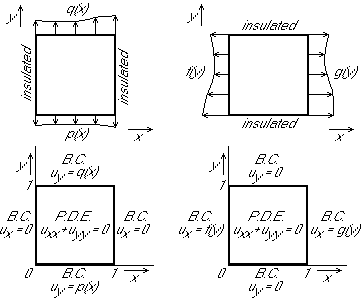

Standard approach:
All boundary conditions are inhomogeneous. Our standard approach would be to set u=u0+v where
![]()
![]()
This would work without any problems. A u0 quadratic in x would be fine. Of course, this choice for u0 is quite arbitrary.
Alternative approach:
Instead, we will follow a more elegant procedure that does not require us to arbitrarily choose a u0. Unfortunately, this alternative procedure will get us into some trouble.
The idea is that the given problem can be seen as the sum of two problems, each with homogeneous boundary conditions in one direction.

The instructor will solve the left hand problem. The students will solve the right hand problem, identify the difficulty, and fix it. Note that the four-problem procedure in the book has the problem even worse.